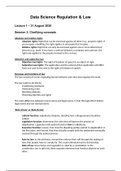Notes de cours
Lecture summary Data Science Regulations & Law Cluster 1, 2, 3
- Cours
- Établissement
This summary almost annotates the lectures of Data Science Regulations & Law for Part I: introduction, private law, and IP law. This is fully complementary to the readers of the lecturers.
[Montrer plus]



